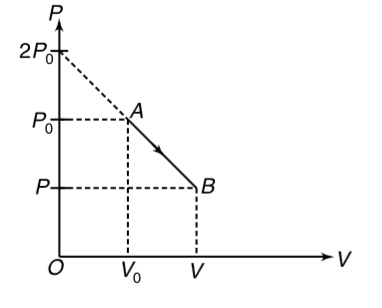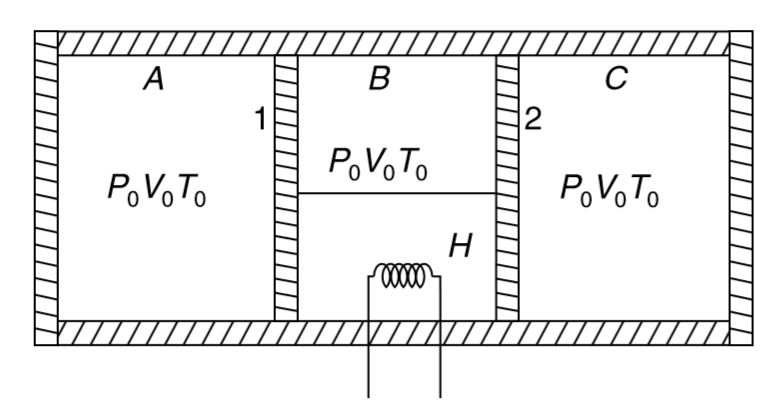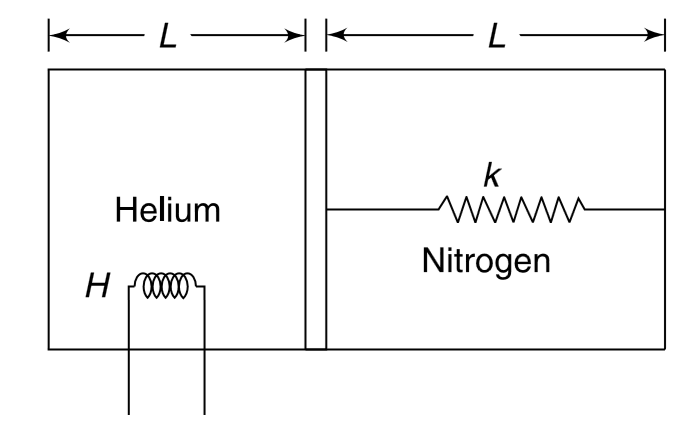Complete Solutions to Level 3 of chapter FIRST LAW OF THERMODYNAMICS of Class 11 book with complete answers and questions
| Class 11 | PHYSICS |
| Chapter | FIRST LAW OF THERMODYNAMICS |
| ARIHANT MASTER PROBLEM | Level 3 |
| Number Of Questions | 6 |
| Academic Year | 2023-24 |
An adiabatic cylinder of cross section A is fitted with a mass less conducting piston of thickness d and thermal conductivity K. Initially, a monatomic gas at temperature `T_(0)` and pressure `P_(0)` occupies a volume `V_(0)` in the cylinder. The atmospheric pressure is `P_(0)` and the atmospheric temperature is `T_(1) (gt T_(0))`. Find
(a) the temperature of the gas as a function of time
(b) the height raised by the piston as a function of time.
Neglect friction and heat capacities of the container and the piston.
View SolutionOne mole of an ideal gas is expanded from the state `A(P_(0), V_(0))` to final state B having volume V. The process follows a path represented by a straight line on the P–V diagram (see figure). Up to what volume (V) the gas shall be expanded so that final temperature is half the maximum temperature during the process.

View SolutionAn ideal gas, in initial state 1`(P_(1), V_(1), T_(1))` is cooled to a state 3`(P_(3), V_(3), T_(3))` by a process which can be represented by a straight one on the P–V graph. The same gas in a different initial state 2 `(P_(2), V_(2), T_(1))` is cooled to same final state 3 `(P_(3), V_(3), T_(3))` by a process which can also be represented by a straight line on the same P–V graph. `Q_(1)` and `Q_(2)` are heat rejected by the gas in the two processes. Which is larger `Q_(1)` or `Q_(2)`. It is given that `P_(1) gt P_(2).
View SolutionIn ideal gas is enclosed in an adiabatic container having cross section `A = 27 cm^(2)` for a part of it and `(A)/(2)` for remaining part. Pistons `P_(1)` and `P_(2)` can move freely without friction along the inner wall. In the position shown in the figure the spring attached to the piston `P_(1)` is relaxed. Sprig constant the spring is `K = 3700 N//m`. Piston `P_(2)` is pushed up gradually through a distance `(H)/(2)` and its was observed that the piston `P_(1)` goes up by `(3H)/(32)` . Take `gamma = 1.5`, mass of piston `P_(1) = 13.5 kg` and atmospheric pressure `P_(0) = 1 xx 10^(5) N//m^(2)`
(a) Find H.
(b) Find final temperature of the gas if its initial temperature is 300 K.

View SolutionAn insulated cylinder is divided into three parts A, B and C. Pistons 1 and 2 are connected by a rigid rod and can slide without friction inside the cylinder. Piston 1 is perfectly conducting while piston 2 is perfectly insulating. Equal quantity of an ideal gas is filled in three compartments and the state of gas in every part is same `(P_(0) V_(0) T_(0))`. Adiabatic exponent of the gas is g = 1.5. The compartment B is slowly given heat through a heater H such that the final volume of gas in part C becomes `(4V_(0))/(9)`
(a) Calculate the heat supplied by the heater.
(b) Calculate the amount of heat flow through piston 1.
(c) If heater were in compartment A, instead of B how would your answers to (a) and (b) change?

View SolutionAn adiabatic cylinder has length 2 L and cross sectional area A. A freely moving non conducting piston of negligible thickness divides the cylinder into two equal parts. The piston is connected to the right face of the cylinder with an ideal spring of force constant k. The right chamber contains 28 g nitrogen in which one third of the molecules are dissociated into atoms. The left chamber container 4 g helium. With piston in equilibrium and spring relaxed the pressure in both chamber is `P_(0)`. The helium chamber is slowly given heat using an electric heater (H), till the piston moves to right by a distance `(3L)/(4)`. Neglect the volume occupied by the spring and the heating coil. Also neglect heat capacity of the spring.
(a) Find the ratio of `C_(P)` and `C_(V)` for nitrogen gas in right chamber.
(b) Calculate change in temperature of helium.
(c) Calculate heat supplied by the heater.

View Solution
Level 3 questions and complete solutions for chapter FIRST LAW OF THERMODYNAMICS of ARIHANT PHYSICS (HINGLISH) of Class 11